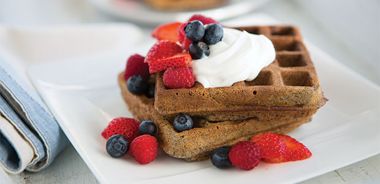Buckwheat Waffles or Pancakes

I can never decide which is better—the pancake or the waffle. Sitting on a plate with fresh fruit and some yogurt, both can be a filling breakfast or brunch dish that will delight all those around the table.
1 1/4 cups (310 mL) organic buckwheat flour
2 tsp (10 mL) baking powder
1/2 tsp (2 mL) salt
2 large free-range eggs, separated
1 cup (250 mL) milk
2 Tbsp (30 mL) maple syrup
1/4 cup (60 mL) grapeseed or sunflower oil
Sift dry ingredients together into large bowl. Beat egg yolks, milk, syrup, and oil together in separate bowl. Stir into dry ingredients. Beat egg whites until stiff and fold into dry mixture.
For waffles, cook using waffle iron until golden; for pancakes, pour 1/4 cup (60 mL) into lightly greased pan and cook until bubbles break the surface. Flip and cook until golden.
Makes 8 waffles or pancakes.
Each waffle or pancake contains: 172 calories; 5 g protein; 9 g total fat (2 g sat. fat, 0 g trans fat); 19 g total carbohydrates (5 g sugars, 1 g fibre); 256 mg sodium
source: "Introducing Buckwheat Flour", alive #387, January 2015




